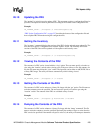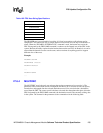
228 MPCMM0001 Chassis Management Module Software Technical Product Specification
FRU Update Configuration File
• As the configuration file is parsed, on each line the correct number of quotes is checked and
when incorrect, flagged as an error prior to checking for the correct number of arguments.
• White space is defined as space, tab, and Carriage Return-Line Feed characters (CR-LF).
27.4 Numeric Constraints
• All numbers are considered decimal unless denoted by the hexidecimal prefix string.
• If as number starts with “0x”, then number is interpreted as hexidecimal.
27.5 Tags
Tags are a means for the configuration file to control the path for users of the file. Tags are a
Boolean (true / false) value represented by a string. When the tag is set, a string for that tag is added
to a utility wide (master) list of set tags. When a tag is cleared, all tags with that string are cleared
from the master list of tags, thus making the tag false. Only tags present in the master list are true,
all other tags are false. Tags are only set, cleared, and checked during the processing phase of the
configuration file. The order in which the tags are set, cleared, and checked is very important. A tag
that is set after it is checked by a statement will be false for the statement.
27.6 Control Commands
These commands are used to control the execution path of the configuration file. This is done with
the setting, clearing, and checking of tags. The control commands are the following: IFSET, ELSE,
ENDIF, SET, CLEAR, CFGNAME, ERRORLEVEL, PROBE, FOUND, PROMPT, YES, NO,
MENUTITLE, MENU, and MENUPROMPT. The commands PROMPT, YES, NO, MENUTITLE,
MENU, and MENUPROMPT are covered in Section 27.6, “Control Commands” on page 228, and
PROBE and FOUND are covered in Section 27.7, “Probing Commands” on page 230.
27.6.1 IFSET
The IFSET statement will take an unlimited number of tags for its arguments, with an implicit
AND between each argument. Each IFSET statement must have a matching ENDIF statement, and
if desired, can have one ELSE statement between the two. If the tags required by the IFSET
command are set during the processing of the configuration file, the commands following the
IFSET command and up to the first ELSE or ENDIF command will be processed and executed. If
the tags are not set, the commands up to the next ELSE or ENDIF command are skipped.
Example:
SET TRUE
IFSET “TRUE”
// Do this stuff
ELSE
// Skip this stuff
ENDIF


















